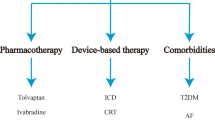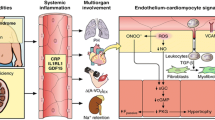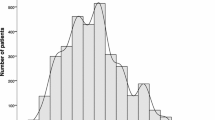Abstract
Despite recent advances in the management of heart failure with reduced ejection fraction (HFrEF), the burden of acute heart failure (AHF) remains significant with a high morbidity and mortality that has not been improved by any treatment modality. A meta-analysis summarized the study results on the effects of tolvaptan on AHF, which failed to demonstrate an improvement in short-term and long-term mortality, length of hospital stay and reduced frequency of worsening heart failure (WHF). Similar trial results were also reported in other AHF studies, such as the ASCEND-HF and the RELAX-AHF-2 trials. In view of these inconclusive studies it is evident that improving the prognosis of AHF patients remains an unmet medical need. Further efforts should focus on organ damage protection, individualized treatment, patient benefits and standardized management programs, including immediate identification and management of cardiogenic shock and establishment of HF networks for close monitoring of AHF patients.
Zusammenfassung
Trotz jüngster Fortschritte im Management der Herzinsuffizienz mit reduzierter Ejektionsfraktion (HFrEF) bleibt die Belastung des akuten Herzversagens („acute heart failure“, AHF) mit hoher Morbidität und Mortalität signifikant und konnte bisher durch kein Behandlungsverfahren verbessert werden. Eine Metaanalyse fasste die Studienergebnisse zu den Auswirkungen von Tolvaptan auf AHF zusammen, das keine Verbesserung in Kurzzeit- und Langzeitmortalität, Hospitalisationsdauer und reduzierter Häufigkeit einer Verschlimmerung der Herzinsuffizienz („worsening heart failure“, WHF) zeigen konnte. Ähnliche Ergebnisse wurden auch in anderen AHF-Studien berichtet, wie z. B. der ACENT-HF- und der RELAX-AHF-2-Studie. In Anbetracht dieser nicht eindeutigen Studienlage stellt die Verbesserung der Prognose von AHF-Patienten offensichtlich einen unerfüllten medizinischen Bedarf dar. Zukünftige Bemühungen sollten auf den Schutz vor Organschäden, die individuelle Behandlung, den Nutzen für die Patienten sowie standardisierte Management-Programme fokussieren, einschließlich der sofortigen Identifizierung und des Managements eines kardiogenen Schocks sowie der Einrichtung von Herzinsuffizienz-Netzwerken für ein engmaschiges Monitoring von AHF-Patienten.
Similar content being viewed by others
Abbreviations
- AHF:
-
Acute heart failure
- HF:
-
Heart failure
- HFrEF:
-
Heart failure with reduced ejection fraction
- IABP:
-
Intra-aortic balloon pump
- LVAD:
-
Left ventricular assist devices
- LVEF:
-
Left ventricular ejection fraction
- MCS:
-
Mechanical circulatory support
- WHF:
-
Worsening heart failure
References
Ponikowski P, Voors AA, Anker SD et al (2016) 2016 ESC Guidelines for the diagnosis and treatment of acute and chronic heart failure: The Task Force for the diagnosis and treatment of acute and chronic heart failure of the European Society of Cardiology (ESC) Developed with the special contribution of the Heart Failure Association (HFA) of the ESC. Eur Heart J 37(27):2129–2200
Gheorghiade M, Pang PS (2009) Acute heart failure syndromes. J Am Coll Cardiol 53(7):557–573
Siirila-Waris K, Lassus J, Melin J et al (2006) Characteristics, outcomes, and predictors of 1‑year mortality in patients hospitalized for acute heart failure. Eur Heart J 27(24):3011–3017
Maggioni AP, Dahlstrom U, Filippatos G et al (2010) EURObservational Research Programme: the Heart Failure Pilot Survey (ESC-HF Pilot). Eur J Heart Fail 12(10):1076–1084
Gheorghiade M, Zannad F, Sopko G et al (2005) Acute heart failure syndromes: current state and framework for future research. Circulation 112(25):3958–3968
Mebazaa A, Yilmaz MB, Levy P et al (2015) Recommendations on pre-hospital and early hospital management of acute heart failure: a consensus paper from the Heart Failure Association of the European Society of Cardiology, the European Society of Emergency Medicine and the Society of Academic Emergency Medicine—short version. Eur Heart J 36(30):1958–1966
Wang C, Xiong B, Cai L (2017) Effects of tolvaptan in patients with acute heart failure: a systematic review and meta-analysis. BMC Cardiovasc Disord 17(1):164
Huang WL, Yang Y, Yang J et al (2017) Use of tolvaptan vs. furosemide in older patients with heart failure: meta-analysis of randomized controlled trials. Herz. https://doi.org/10.1007/s00059-017-4563-4
O’Connor CM, Starling RC, Hernandez AF et al (2011) Effect of nesiritide in patients with acute decompensated heart failure. N Engl J Med 365(1):32–43
Packer M, O’Connor C, McMurray JJV et al (2017) Effect of ularitide on cardiovascular mortality in acute heart failure. N Engl J Med 376((20):1956–1964
Mitrovic V, Seferovic PM, Simeunovic D et al (2006) Haemodynamic and clinical effects of ularitide in decompensated heart failure. Eur Heart J 27(23):2823–2832
Dschietzig TB (2014) Recombinant human relaxin-2: (how) can a pregnancy hormone save lives in acute heart failure? Am J Cardiovasc Drugs 14(5):343. https://doi.org/10.1007/s40256-014-0078-z
Teerlink JR, Cotter G, Davison BA et al (2013) Serelaxin, recombinant human relaxin-2, for treatment of acute heart failure (RELAX-AHF): a randomised, placebo-controlled trial. Lancet 381(9860):29–39
Teerlink JR, Voors AA, Ponikowski P et al (2017) Serelaxin in addition to standard therapy in acute heart failure: rationale and design of the RELAX-AHF-2 study. Eur J Heart Fail 19(6):800. https://doi.org/10.1002/ejhf.830
https://www.novartis.com/news/media-releases/novartis-provides-update-phase-iii-study-rlx030-serelaxin-patients-acute-heart. Accessed 22 March 2017
Metra M, Cotter G, Davison BA et al (2013) Effect of serelaxin on cardiac, renal, and hepatic biomarkers in the Relaxin in Acute Heart Failure (RELAX-AHF) development program: correlation with outcomes. J Am Coll Cardiol 61(2):196–206
Voors AA, Dahlke M, Meyer S et al (2014) Renal hemodynamic effects of serelaxin in patients with chronic heart failure: a randomized, placebo-controlled study. Circ Heart Fail 7(6):994–1002
Liu LC, Voors AA, Teerlink JR et al (2016) Effects of serelaxin in acute heart failure patients with renal impairment: results from RELAX-AHF. Clin Res Cardiol 105(9):727–737
Thiele H, Zeymer U, Neumann FJ et al (2012) Intraaortic balloon support for myocardial infarction with cardiogenic shock. N Engl J Med 367(14):1287–1296
Estep JD, Starling RC, Horstmanshof DA et al (2015) Risk assessment and comparative effectiveness of left ventricular assist device and medical management in ambulatory heart failure patients: results from the ROADMAP study. J Am Coll Cardiol 66(16):1747–1761
Tschope C, Pieske B (2016) “One size does not fit all”: how to individualize decongestive therapy strategies in heart failure. JACC Heart Fail 4(6):460–463
Konstam MA (2013) RELAX-AHF: rising from the doldrums in acute heart failure. Lancet 381(9860):5–6
Zannad F, Garcia AA, Anker SD et al (2013) Clinical outcome endpoints in heart failure trials: a European Society of Cardiology Heart Failure Association consensus document. Eur J Heart Fail 15(10):1082–1094
Angermann CE, Stork S, Gelbrich G et al (2012) Mode of action and effects of standardized collaborative disease management on mortality and morbidity in patients with systolic heart failure: the Interdisciplinary Network for Heart Failure (INH) study. Circ Heart Fail 5(1):25–35
Ertl G, Angermann CE, Bekeredjian R et al (2016) Structure and organization of heart failure networks (HF-NETs) and heart failure units (HFUs) to optimize treatment of acute and chronic heart failure. Kardiologe 10(4):222–235
Author information
Authors and Affiliations
Corresponding author
Ethics declarations
Conflict of interests
A.G. Rigopoulos, R. de Vecchis, S. Sakellaropoulos, M. Ali, M. Teren and M. Matiakis declare that they have no competing interests. C. Bakogiannis was employed by Novartis from August 2013 to July 2015. M. Noutsias received grants from the Deutsche Forschungsgemeinschaft (DFG) through the Sonderforschungsbereich Transregio 19 “Inflammatory Cardiomyopathy” (SFB TR19) (TP B2) and from the University Hospital Gießen and Marburg Foundation Grant “T cell functionality” (UKGM 10/2009). He was consultant to the Institute for Cardiac Diagnosis and Therapy (IKDT, Berlin) from June 2004 to June 2008, and received fees for presentations and/or participation in advisory boards from AstraZeneca, Bayer, Fresenius, Miltenyi Biotech, Novartis, Pfizer and Zoll and is the local principal investigator (p. i.) of the trials RELAX-AHF-2, TRUE-HF and TRANSITION trials at the University Hospital Jena. C. Tschoepe received a grant by the DFG (SFB TR19 TP B5 and Z3).
This article does not contain any studies with human participants or animals performed by any of the authors.
Additional information
Angelos G. Rigopoulos and Constantinos Bakogiannis contributed equally to this work.
Rights and permissions
About this article
Cite this article
Rigopoulos, A.G., Bakogiannis, C., de Vecchis, R. et al. Acute heart failure. Herz 44, 53–55 (2019). https://doi.org/10.1007/s00059-017-4626-6
Received:
Revised:
Accepted:
Published:
Issue Date:
DOI: https://doi.org/10.1007/s00059-017-4626-6




